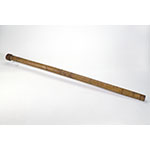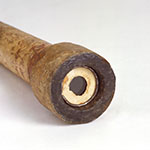Original telescope made by Galileo consisting of a main tube and two smaller housings in which the objective and the eyepiece are mounted. The main tube consists of two semicircular tubes held together with copper wire. It is covered with paper. The objective measures 51 mm in diameter, and is biconvex, but the radii of curvature of the surfaces of the two faces are not equal; the focal length is 1,330 mm, the thickness at the center 2.5 mm. The eyepiece is plano-concave and measures 26 mm in diameter; the concave side, facing the eye, has a radius of curvature of 48.5 mm; the thickness at the center is 3.0 mm, the focal length -94 mm (the negative focal length means that the lens is diverging). The instrument's magnification is 14 and its field of view 15'. In 1611, Prince Federico Cesi, founder of the Accademia dei Lincei, suggested calling this instrument telescopio [from the Greek tēle ("far") and scopeo ("I see")].
Galileo designed ingenious accessories for the telescope's various applications. One of the most important was the micrometer, an indispensable device for measuring distances between Jupiter and its moons. Another was the helioscope, which made it possible to observe sunspots through the telescope without risking eye damage.











